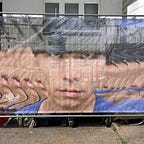SASG Residency Week 8
Week 1 | Week 2 | Week 3 | Week 4 | Week 5 | Week 6 | Week 7
This week, Evelyne and I visited a media art studio of teamVOID and ATOD. Youngkak, who I met at the first mapping party, arranged a dinner for media artists in Seoul and kindly invited us. They are design studios working on both commercial projects for brands and art installations for exhibitions. On the other hand, I found that most of the media art studios in Tokyo work mainly on commercial projects, or even though they work for an exhibition, often the project is led by other artist. I have seen teamVOID and Youngkak’s pieces at Elektra in Montreal last year and it is nice to finally meet them in person. Also, we met Mathias, who is an artist in residence at Art Center Nabi working on an installation that uses blockchain. We went to a barbecue restaurant near their studios and talked about their current projects and challenges both for artwork and commercial work. If you are going to Linz, Austria, teamVOID is going to exhibit its robot piece at Ars Electronica next month so you can find their work (and you can even buy artwork drawn by the robot!).
The artists at SASG were supposed to go for a gallery tour on Friday, but because of the typhoon approaching the city, unfortunately it was cancelled on the day before the trip. Nevertheless, the typhoon did not hit Seoul and the rain was not hard on Friday, so I decided to attend an artist talk by Amay hosted by Art Center Nabi. Amay is another residence artist at Nabi working on blockchain and media art, and in the presentation, he explained the concepts and technical details. His idea is to own his body by encoding data on cryptocurrency as a virtual identity. He was first interested in saving data of human cells, but as a proof of concept, he chose dance movements as a subject. Each “groove token” has information about a small portion of a dance move, and owning these tokens virtually allow you to own a dance skill. The residency artists’ installations will be exhibited on September 5th as well as a blockchain exhibition in November.
Aside from the technical implementation, I was interested in the reason why he chose dance movements as information of body. Although he mentioned the idea of embodying the body itself through blockchain and owning the tokens, dance movements can be ephemeral and once recorded they are detached from the physical body. There are projects digitizing movements and choreography, such as Motion Bank, but in their case, the movement database is not only for archiving but is to be reviewed and annotated by other dancers and choreographers to keep the connection of physical body and recorded movements. Since it is a preliminary work, I am curious to know how he will expand his project after his residency.
